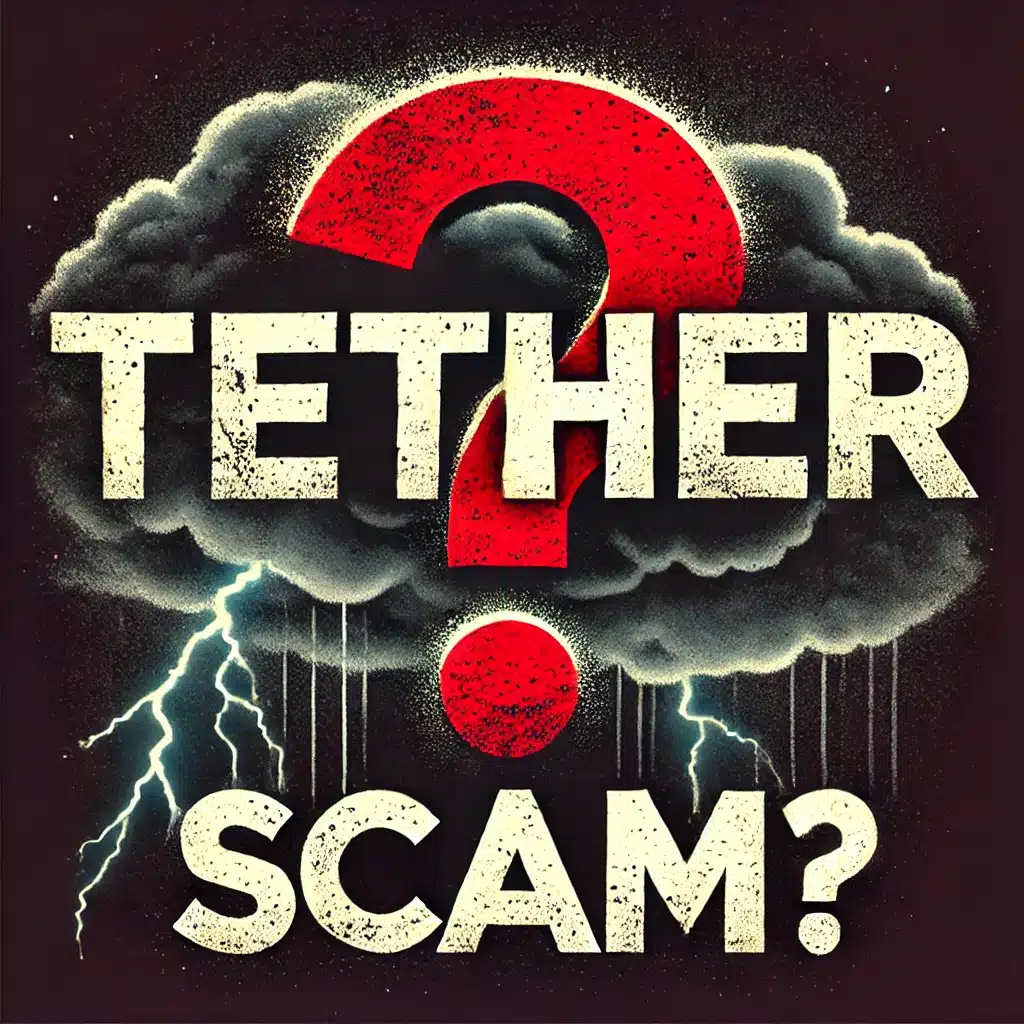Tether Under Investigation From The U.S. Department of Justice (DOJ)

What if Tether were Just a Big Scam?
The U.S. Department of Justice (DOJ), in coordination with the U.S. Attorney’s Office in Manhattan, has intensified its investigation into Tether, the issuer of the USDT stablecoin. A report by The Wall Street Journal suggest the focus is on possible violations of anti-money laundering laws and sanctions regulations, investigating whether Tether facilitated transactions for criminal networks engaged in drug trafficking, terrorism financing, and cybercrime activities.
As we told to WSJ there is no indication that Tether is under investigation. WSJ is regurgitating old noise. Full stop.
— Paolo Ardoino(@paoloardoino) October 25, 2024
CEO Paolo Ardoino has dismissed these allegations, calling them “old noise” and stressing Tether’s cooperation with law enforcement to mitigate misuse of its assets. Yet, without a credible audit or transparency about Tether’s reserves, the company’s practices remain under intense scrutiny from regulators and critics alike.
Jordan Belfort, the former stockbroker known as the “Wolf of Wall Street” and current crypto bull, discussed a few years back why he thinks stablecoin USDT issuer Tether is a scam. “I’ve been saying that since 2017 that I thought there was a big problem with Tether,” Belfort said.
Treasury Department Considers Sanctions Against Tether
The DOJ’s investigation into Tether marks an escalation in the scrutiny surrounding the stablecoin giant’s operations, with sources indicating potential violations tied to facilitating global criminal activity. Specifically, the DOJ and the U.S. Attorney’s Office in Manhattan are focusing on whether Tether violated anti-money laundering laws and sanctions by enabling transactions linked to drug trafficking, terrorism financing, and hacking, plus suspected connections between Tether transactions and sanctioned entities, particularly in Russia and the Middle East.
The Treasury Department may take additional action, including imposing sanctions on Tether, a move that would prohibit American businesses from engaging with the stablecoin issuer. If sanctioned, Tether’s role in global crypto finance could be at risk, especially in markets where it acts as a dollar alternative in regions with limited U.S. dollar access, such as Lebanon and Argentina.
A History of Regulatory Challenges and Transparency Concerns
JUST IN:
— Good Morning Crypto (@AbsGMCrypto) October 25, 2024US Government launches investigation into $USDT crypto firm Tether!
Ripple CEO Brad Garlinghouse Issued a Black-swan Warning 5 months ago about Tether, The Largest Stablecoin Issuer On The Planet!
"The US Government Is Going After Tether. That Is Clear To Me." -… pic.twitter.com/1TU8xDZner
Tether’s history with regulators is extensive. In 2021, the Commodity Futures Trading Commission fined Tether $41 million for allegedly misrepresenting the backing of its stablecoin. That same year, the New York Attorney General’s office levied an $18.5 million fine on Tether and its parent company, iFinex, for operating unlawfully and lacking transparency about their reserve assets.
Further concerns arose after blockchain analytics firms, including TRM Labs, identified Tether as a key tool for global criminal networks. A TRM Labs report indicated that nearly 45% of illicit crypto transactions were conducted via Tether, particularly on the Tron blockchain, which hosts more than half of Tether’s current $120 billion market cap. Despite Tether’s claims of efforts to curb illegal use, this report shows ongoing issues related to oversight and transparency.
The current investigation poses a potential existential threat to Tether and, by extension, the broader crypto market. Comparisons have been drawn to the collapse of the FTX exchange in 2022, which sent shockwaves through the industry.
Tether Probably Fuels Pump and Dump Schemes
But that’s not all, there are clear signs that Tether is also involved in pump and dunp schemes due to its large volume and usage. In “pump and dump” schemes, coordinated buying drives prices up artificially, only for key players to sell off their holdings, leaving smaller investors with losses.
As we said earlier common criticism is that Tether has historically issued USDT without clear, transparent backing in actual U.S. dollars. If Tether issues unbacked tokens, it increases the supply of USDT in circulation, providing fuel for speculative buying that can artificially inflate crypto prices. Critics argue that this “extra” liquidity may help drive the “pump” phase of a pump-and-dump cycle, allowing for larger volumes of trades that can artificially inflate prices without true market demand.
The accusations are not made out of thin air. Tether is most probably used to inflate asset prices so academic and industry studies suggest. These studies also claim that large-scale purchases of Bitcoin and other cryptocurrencies were correlated with Tether issuances during market peaks. This dynamic can create a perception of demand and drive prices higher than they might naturally be, setting up a favorable environment for a “dump” as major players sell off at peak prices.
Paolo Ardoino is so confident that Tether isn't under criminal investigation, that he doesn't show up in New York for a Crypto Conference, instead choosing to Zoom it in.
— Bitfinex'ed
If you're so sure you're not under criminal investigation, you'd show up on US soil.Κασσάνδρα
(@Bitfinexed) October 25, 2024
What if Tether is Indeed under Scrutiny?
If the DOJ investigation into Tether’s alleged sanctions violations and money laundering is substantiated, there are several potential next steps that could unfold, each with repercussions for Tether, the crypto industry, and the regulatory landscape.
1. Formal Charges and Sanctions
If investigators conclude that Tether knowingly facilitated transactions for criminal networks or sanctioned entities, the DOJ could press charges. Formal charges could involve severe penalties or restrictions, including:
- Financial Penalties: Tether might face substantial fines, similar to past settlements where companies violated U.S. sanctions or anti-money laundering regulations.
- Sanctions by the Treasury Department: The Treasury could impose sanctions on Tether, which would restrict U.S.-based institutions from dealing with the stablecoin issuer, effectively removing Tether’s ability to operate within the U.S. financial system. Such sanctions could force exchanges, businesses, and financial institutions globally to reconsider their interactions with Tether.
2. Increased Oversight and Audits
Regulatory agencies may demand transparency reforms, including independent audits of Tether’s reserves and financial practices. Audits could verify whether Tether has sufficient backing for its stablecoin and if reserves comply with international financial standards. This could help mitigate the longstanding concern that Tether’s reserves might be misrepresented or insufficiently liquid.
With Tether potentially facing restrictions, market participants may also shift toward stablecoins with more transparent regulatory frameworks, such as USDC, which is backed by Circle and regulated by U.S. authorities.
3. Market Repercussions and Investor Confidence
Any formal charges or penalties would impact Tether’s market perception and stability, which could disrupt the broader crypto market. With Tether acting as the primary stablecoin in global crypto trading, a loss of investor confidence could lead to a liquidity crisis, especially for traders and markets heavily dependent on USDT for transactions and settlements.
4. Potential Ripple Effect in the Stablecoin Sector
An adverse ruling against Tether could increase regulatory scrutiny across the stablecoin sector. Rivals like USDC and new stablecoin initiatives could also face stricter controls. This scrutiny could lead to clearer regulatory frameworks for stablecoins, particularly in markets with historically loose oversight.
5. Exit from Certain Markets
If Tether’s international operations come under severe sanctions, the company may need to exit certain markets, particularly those with strict compliance standards, like the U.S., Europe, and other developed nations. This scenario could drive demand for other stablecoins and force Tether to reconsider its offshore operational model.
6. Industry-wide Regulatory Reforms
If Tether is found guilty of facilitating illicit transactions, lawmakers may feel increased pressure to fast-track regulations specific to stablecoins. This could lead to the imposition of stablecoin reserve requirements, stringent KYC (Know Your Customer) and AML (Anti-Money Laundering) practices, and compulsory disclosures, reshaping the stablecoin and crypto industries as a whole.
The outcome of this investigation could thus set a precedent, shaping how regulators worldwide handle crypto assets and stablecoins, potentially altering the industry’s trajectory.
A Pivotal Moment for the Stablecoin Sector
The DOJ’s investigation into Tether signals a pivotal moment for the stablecoin sector, potentially transforming how these assets are regulated and used. This scrutiny shows – again – a need for transparency and regulatory compliance. If Tether is penalized or sanctioned, it may prompt a shift toward stablecoins with clearer compliance records, such as USDC, and could drive new demand for audited and regulated assets.
The implications extend beyond Tether itself. Increased regulatory involvement in stablecoins would likely enforce regular audits, transparency in reserve backing, and stringent anti-money laundering protocols across the board. This shift could also stabilize the market, benefiting users who rely on stablecoins for international transactions, trading, and DeFi activities, though with potential drawbacks in liquidity and flexibility if Tether’s influence diminishes suddenly.
In essence, Tether’s ongoing probe is shaping up to be a litmus test for the future of digital assets. It could accelerate stablecoin market restructuring, encourage global policy adoption, and solidify a new standard for transparency in digital finance, ultimately fostering a more resilient and credible crypto landscape.








